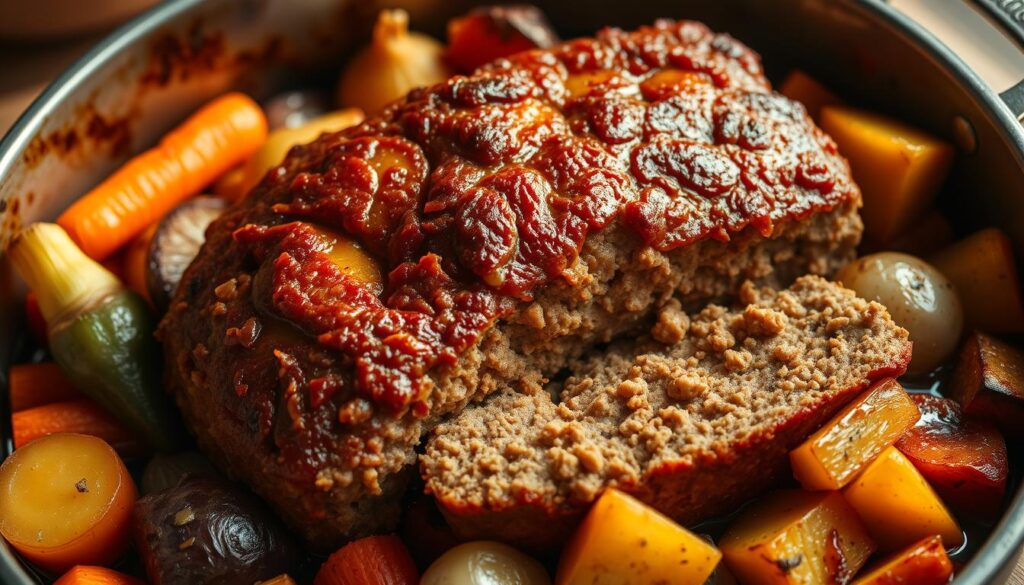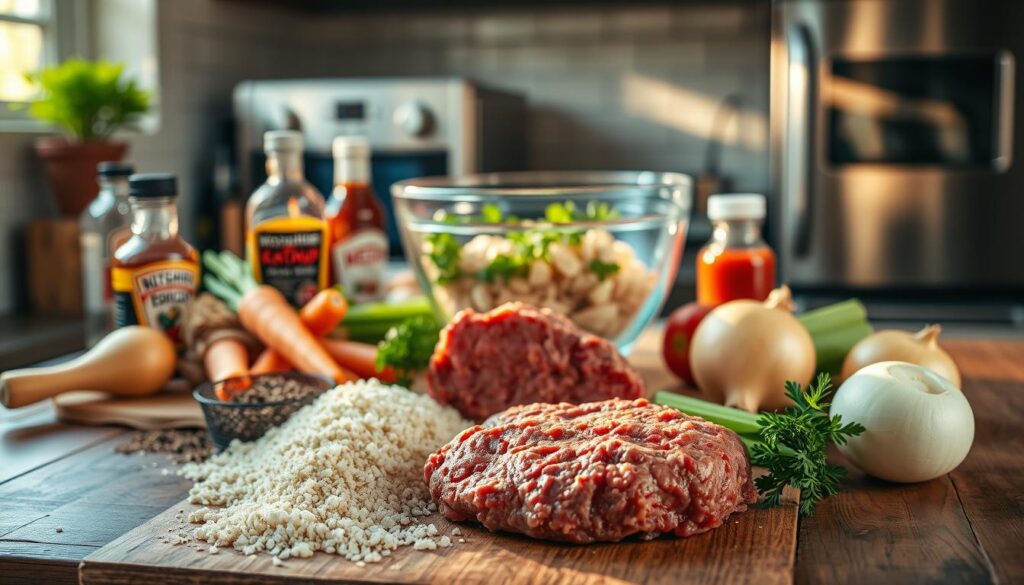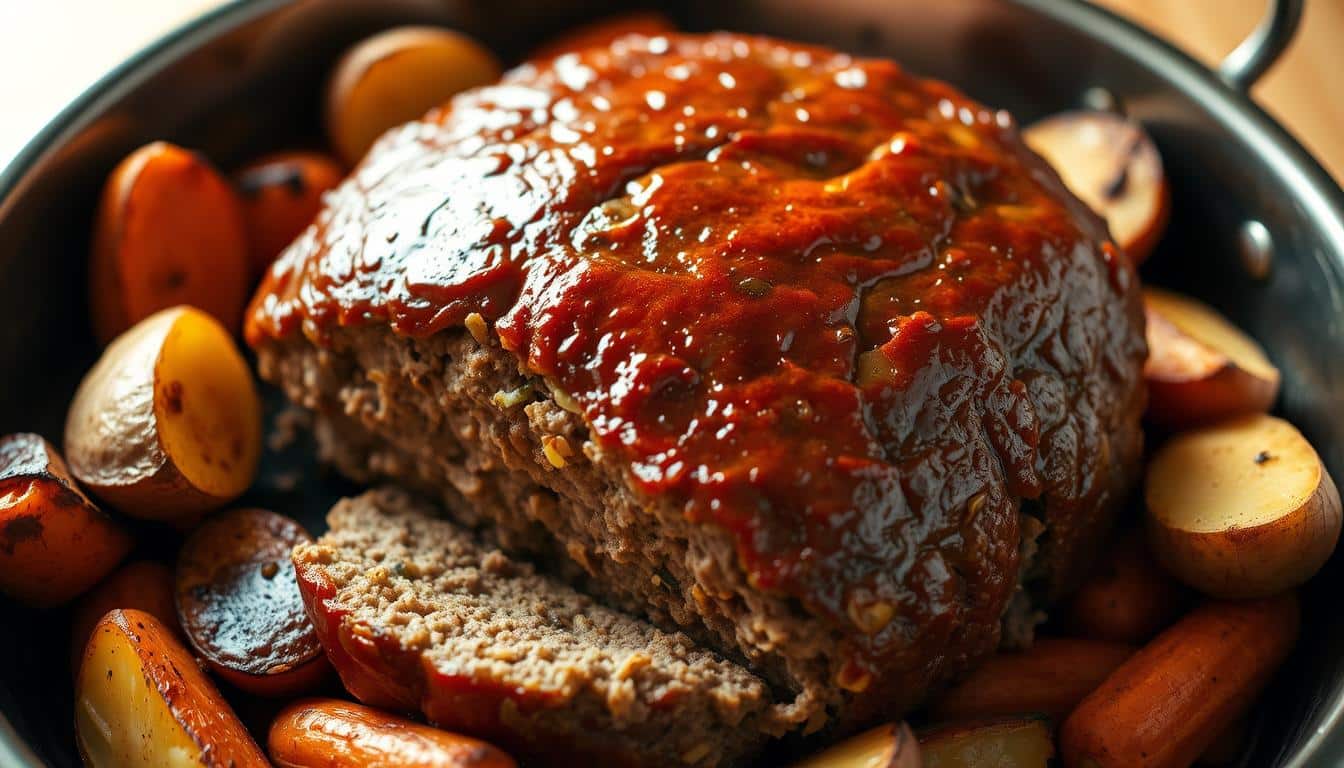Are you tired of complicated cooking methods that leave you with a sink full of dishes? Looking for a recipe with meatloaf that’s simple and mess-free? You can make a delicious meatloaf in just one pan — yes, it’s easier than you think.
Imagine cooking a mouth-watering meatloaf along with your favorite sides in a single pan. This can be done in a reasonable cooking time. You’ll need ingredients like 1 lb of ground beef, 1/2 cup of breadcrumbs, 1/2 cup chopped onion, and 1 egg, among others.
This article will guide you through the process. It will show you a simple and convenient way to cook a perfect meatloaf.
Table of Contents
Key Takeaways
- Learn how to cook a perfect meatloaf in one pan.
- Discover the essential ingredients and their quantities.
- Understand the cooking time and temperature required.
- Find out how to prepare your favorite sides in the same pan.
- Get tips on making the most out of your one-pan meal.
The Benefits of One-Pan Meatloaf Cooking
One-pan meatloaf recipes are great for busy cooks. They make cooking easier and save time. Plus, they make cleaning up a breeze, perfect for weeknights.
Why One-Pan Cooking Saves Time and Effort
One-pan cooking means you can make and cook your meatloaf in one go. This cuts down on the need for many pots and pans. So, you can have a delicious meal with less hassle.
The Best Pans for Perfect Meatloaf
Choosing the right pan is key for a great meatloaf. Several pans work well, each with its perks.
Cast Iron Skillets
Cast iron skillets are top-notch for meatloaf. They heat evenly and give a nice crust. Plus, they work on the stovetop or in the oven.
Baking Dishes
Baking dishes are also excellent. They have plenty of room for the meatloaf and veggies. They’re great for a simple, hands-off cooking method.
Loaf Pans
Loaf pans give your meatloaf a traditional shape. They’re perfect for those who want a uniform loaf. They make sure your meatloaf cooks evenly.

Essential Ingredients for the Perfect Recipe with Meatloaf
To make the perfect meatloaf, start with the right ingredients. The quality and mix of these ingredients greatly affect the final taste.
Meat Selection and Proportions
A great meatloaf starts with its meat mix. A blend of ground meats adds flavor and texture.
Ground Beef (80/20 ratio – 1.5 pounds)
Ground beef with an 80/20 ratio keeps the meatloaf moist. You’ll need about 1.5 pounds of it.
Ground Pork (0.5 pounds)
Adding 0.5 pounds of ground pork enhances flavor and keeps the meatloaf juicy.
Binding Ingredients
Binding ingredients are key. They keep the meatloaf together, so it doesn’t fall apart while cooking.
Eggs (2 large)
Two large eggs bind the meatloaf. They add moisture and richness.
Breadcrumbs (3/4 cup)
Three-quarters cup of breadcrumbs absorbs moisture and adds texture.
Milk (1/3 cup)
One-third cup of milk moistens the breadcrumbs. It makes the meatloaf juicier.
Aromatics and Vegetables
Aromatics and vegetables add depth and complexity to the meatloaf.
Onions (1 medium, finely diced)
One medium onion, finely diced, adds a sweet and savory flavor.
Garlic (3 cloves, minced)
Three cloves of minced garlic enhance the flavor.
Bell Peppers (1/2 cup, diced)
Diced bell peppers add crunch and sweetness.
Seasonings and Herbs
The right seasonings and herbs elevate the meatloaf’s flavor.
Salt (1.5 teaspoons)
One and a half teaspoons of salt enhance the flavors of the other ingredients.
Black Pepper (1 teaspoon)
One teaspoon of black pepper adds a sharp flavor.
Worcestershire Sauce (2 tablespoons)
Two tablespoons of Worcestershire sauce add a savory taste.
Italian Herbs (1 tablespoon)

By mixing these ingredients correctly, you’ll make a delicious meatloaf. Remember, the key is not just the ingredients. It’s also how you mix and cook them, including knowing what temperature to bake meatloaf for the best results in your recipe with meatloaf.
Preparing Your One-Pan Meatloaf Mixture
Creating the perfect one-pan meatloaf begins with a balanced mix. It’s important to know the role of each part and how they blend.
Sautéing Vegetables in Your Pan First
Start by sautéing your vegetables in the pan before mixing them with the meatloaf. This step boosts their taste and texture. Cooking onions, bell peppers, and mushrooms until soft and fragrant adds richness to your meatloaf. Choose your favorite vegetables for a unique taste.
Proper Mixing Techniques
After sautéing your veggies, mix them with the other ingredients. Using the right mixing techniques is key to a light meatloaf. Mix gently with your hands or a spoon until just combined. Avoid mixing too much to prevent a tough texture.
- Combine ground meat with sautéed vegetables, breadcrumbs, eggs, and seasonings.
- Mix the ingredients until they are just combined.
- Be gentle to avoid compacting the mixture.
Testing for Consistency
To check if your mix is ready, shape a small part into a loaf. If it holds its shape, it’s good. If not, add more breadcrumbs. If too tight, a bit of egg or milk can help.
Common Mixing Mistakes to Avoid
When mixing your meatloaf, avoid a few common mistakes. Overmixing is a big no-no, as it makes the meatloaf dense and tough. Also, skipping the vegetable sauté can mess up the flavor.
- Avoid overmixing the ingredients.
- Don’t skip sautéing the vegetables.
- Be mindful of the mixture’s consistency.
By following these tips, you’ll make a tasty one-pan meatloaf. A well-prepared mix is crucial, no matter how long to cook the meatloaf.
Shaping and Seasoning Your Meatloaf in the Pan
How you shape and season your meatloaf greatly affects its taste and texture. Shaping it right ensures it cooks evenly. Seasoning boosts its flavor.
Free-Form vs. Loaf Pan Techniques
You can shape your meatloaf free-form or in a loaf pan. Free-form shaping gives a rustic look and a crisper outside. A loaf pan makes it uniform and easier to slice. Pick what you like best.
Creating Space for Vegetables Around the Loaf
Make room around your meatloaf for veggies. This lets veggies soak up the meatloaf’s juices and flavors. Good choices include potatoes, carrots, and onions.
Surface Seasoning Tips
Season the top of your meatloaf for extra flavor. Mix herbs like thyme and rosemary with a bit of paprika for smokiness. Pat the seasonings gently to make sure they stick.
Preventing Sticking to the Pan
To stop your meatloaf from sticking, grease the pan lightly. Use cooking spray or a bit of oil. You can also use parchment paper for easy cleanup.
| Technique | Benefits |
|---|---|
| Free-Form Shaping | Crisper exterior, rustic appearance |
| Loaf Pan Shaping | Uniform shape, easier slicing |
Creating the Perfect Glaze or Topping
Make your one-pan meatloaf even better with a tasty glaze or topping. A good glaze not only tastes great but also looks amazing. It makes your meatloaf more appealing to look at.
Classic Ketchup-Based Glaze
A classic ketchup glaze is always a good choice for meatloaf. You’ll need:
- Ketchup (1/2 cup)
- Brown Sugar (2 tablespoons)
- Mustard (1 tablespoon)
Mix these ingredients until smooth. Then, brush the glaze over your meatloaf for the last 20 minutes of baking.
Savory Alternatives
Want something different? Try these savory options:
- Barbecue Sauce Blend
- Honey-Mustard Glaze
A barbecue sauce blend gives a smoky taste. A honey-mustard glaze is sweet and tangy.
| Glaze Type | Ingredients | Flavor Profile |
|---|---|---|
| Classic Ketchup-Based | Ketchup, Brown Sugar, Mustard | Sweet and Tangy |
| Barbecue Sauce Blend | Barbecue Sauce, Brown Sugar, Worcestershire Sauce | Smoky and Sweet |
| Honey-Mustard Glaze | Honey, Mustard, Lemon Juice | Sweet and Savory |
When and How to Apply Glazes
Put your glaze on during the last 20 minutes of baking. This lets the glaze set and caramelize. It makes your meatloaf taste and feel better. For the best results, brush the glaze on evenly and avoid over-glazing, as this can make the meatloaf too sweet or sticky.
Choosing the right glaze can make your one-pan meatloaf a hit. It’s perfect for any special occasion.
What Temp to Bake Meatloaf and Timing Guidelines
To make a perfectly cooked meatloaf, knowing the right baking temperature and time is key. Baking a meatloaf is simple but needs careful attention to get it just right.
Preheating Your Oven
First, preheat your oven to 350°F (175°C). This ensures your meatloaf cooks evenly.
How Long to Cook a 2 lb Meatloaf
A 2 lb meatloaf usually takes 60-75 minutes to cook at 350°F (175°C). But, the exact time can change based on the meatloaf’s shape and any extra ingredients in the pan.
Here are some general cooking times for meatloaf:
- 1 lb meatloaf : 45-60 minutes
- 1.5 lb meatloaf : 55-70 minutes
- 2 lb meatloaf : 60-75 minutes
Temperature Testing for Doneness
The best way to check if your meatloaf is done is by its internal temperature. It should be 160°F (71°C). Use a meat thermometer to check the center of the meatloaf.
Resting Your Meatloaf
After cooking, let your meatloaf rest for 10-15 minutes before slicing. This makes it more tender and flavorful.
By following these tips, you’ll get a deliciously cooked meatloaf. Remember, patience is key when cooking.
One-Pan Sides to Cook with Your Meatloaf
Cooking your meatloaf with sides in the same pan is a great idea. It makes cleanup easier and lets the flavors mix well. This makes your meal more enjoyable.
Roasted Potatoes Around the Loaf
Roasted potatoes go well with meatloaf. You’ll need baby potatoes (1 pound) and a seasoning mix. This mix includes 2 tablespoons olive oil, salt, and herbs.
Baby Potatoes (1 pound)
Halve or quarter the potatoes, depending on their size. Place them around the meatloaf in the pan.
Seasoning Mix (2 tablespoons olive oil, salt, herbs)
Drizzle olive oil over the potatoes. Sprinkle with salt and herbs, then toss to coat.
Vegetable Medleys
Vegetables add color, texture, and nutrients to your meal. Try mixing carrots and green beans (1 cup each) or Brussels sprouts and onions (1 cup each).
Carrots and Green Beans (1 cup each)
Peel and slice the carrots. Trim the green beans. Toss with olive oil, salt, and pepper, then arrange around the meatloaf.
Brussels Sprouts and Onions (1 cup each)
Trim the Brussels sprouts and slice the onions. Toss with olive oil, salt, and pepper. Spread them around the loaf.
Timing Adjustments for One-Pan Sides
When cooking sides with your meatloaf, adjust the cooking time. Potatoes and root vegetables take longer. Parboil them first if needed. Add green beans later to avoid overcooking.
Troubleshooting Common Meatloaf Problems
Making the perfect meatloaf can be tricky. But, knowing how to fix common issues can help a lot. You might face problems like a dry texture, a soggy bottom, bland flavor, or too much grease. There are ways to solve these problems.
Fixing Dry or Crumbly Meatloaf
A dry or crumbly meatloaf is a letdown. To avoid this, don’t overmix the meat. Adding eggs and breadcrumbs can keep it moist. Also, don’t overbake; use a thermometer to check if it’s done.
Preventing a Soggy Bottom
A soggy bottom can happen if the pan isn’t hot enough or if there’s too much liquid. Preheat the pan well before adding the meat. You can also put the meatloaf on a bed of veggies to improve air flow.
Solutions for Bland Flavor
If your meatloaf tastes bland, it might need more seasoning or aromatics. Adding onions, garlic, and herbs can boost the flavor. Don’t forget to season the top of the meatloaf too.
Dealing with Excess Grease in the Pan
Too much grease can make the meatloaf greasy. To fix this, drain excess fat from the pan while cooking. Or, use a non-stick pan to prevent sticking and make cleaning up easier.
| Issue | Solution |
|---|---|
| Dry or Crumbly Texture | Avoid overmixing; add moisture-retaining ingredients |
| Soggy Bottom | Preheat the pan; elevate the meatloaf on the vegetables |
| Bland Flavor | Add aromatics and seasonings; season the surface |
| Excess Grease | Drain excess fat; use a non-stick pan |
By tackling these common problems, you can make sure your meatloaf is always delicious. For more tips on making a great meatloaf, see our guide on how to make meatloaf.
Conclusion: Mastering Your One-Pan Meatloaf
Now you know how to make the perfect one-pan meatloaf. You’ve learned about the benefits of cooking in one pan. You also know how to pick the right ingredients and bake it just right.
You’ve learned how to shape and season your meatloaf. You’ve also made a tasty glaze and cooked it to the perfect temperature. Plus, you know how to fix common problems and cook sides to go with your meatloaf.
With more practice, you’ll get better at making one-pan meatloaf. Try new ingredients and glazes to make it your own. Soon, you’ll be able to make a delicious meatloaf that everyone will love.

